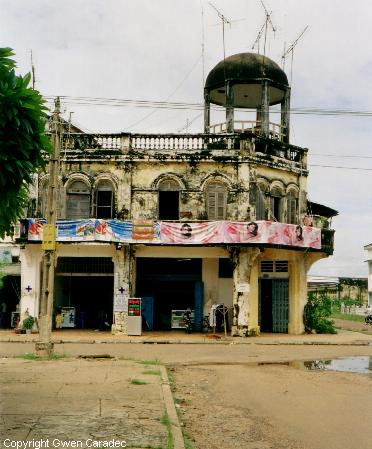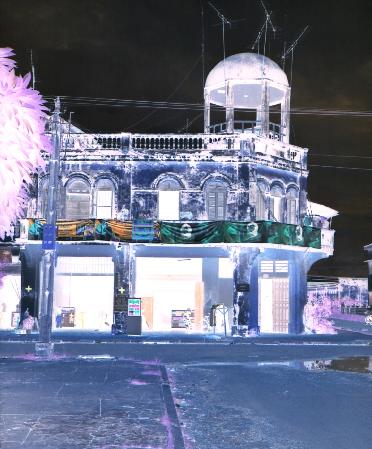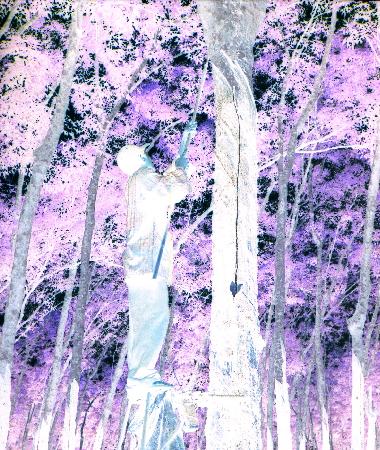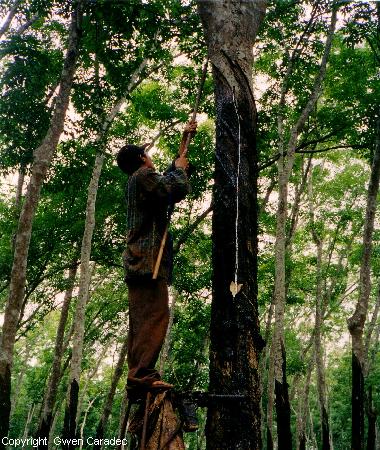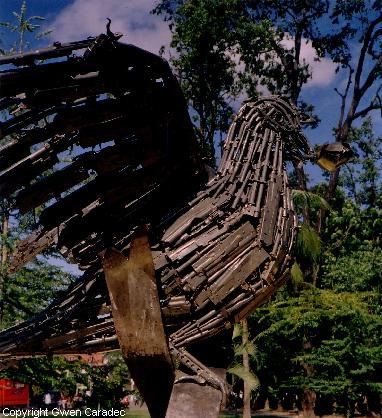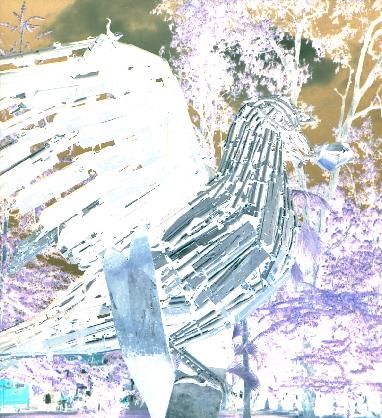RENCONTRER
DIEU |
camboDIATRIBE
|
MEET WITH
GOD |
Cambodia hails arrest of insurgent leader in United States (2005-Jun-03)
Www.Yahoo.Com : Cambodian officials on Thursday hailed U.S.
authorities' arrest of the leader of an insurgent group that tried and
failed to violently overthrow Cambodia's government nearly five years ago.
Government spokesman Khieu Kanharith called the arrest in the United States
of American citizen Chhun Yasith, of
Long Beach, California "a positive move." He described the Cambodian
Freedom Fighters _ the rebel organization Chhun Yasith headed
_ as a terrorist group. Several dozen members of the group, armed with
grenades and machine guns, mounted pre-dawn attacks on government buildings
in Phnom Penh on Nov. 24, 2000. Six attackers and a civilian bystander
were killed. The rebels were easily overwhelmed.
Chhun Yasith, 48, was arrested Wednesday on charges
of conspiracy to kill in a foreign country; conspiracy to damage or destroy
property in a foreign country; and engaging in a military expedition against
a nation with whom the United States is at peace, according to the
U.S. attorney's office in Los Angeles. Chhun Yasith faces life in prison
without parole for each of the charges. A Cambodian court tried him in
absentia in 2001, found him guilty of committing terrorist acts and belonging
to an armed group, and sentenced him to life in prison. In media interviews,
Chhun Yasith has acknowledged his involvement with the group. It
was not immediately clear on Thursday if Cambodia plans to ask for Chhun
Yasith's extradition. The two countries do not have an extradition treaty.
Deputy National Police Chief Sok Phal said that a U.S. Federal Bureau of
Investigation agent had visited Cambodia to gather evidence, and that authorities
were "profoundly" grateful for the arrest. Om Yintieng, a senior adviser
to Prime Minister Hun Sen, also expressed gratitude. But he also complained
that Cambodian officials first requested action many years ago. Cambodian
courts have tried dozens of alleged members of the Cambodian Freedom Fighters,
including two other Cambodian-Americans. They received sentences ranging
from three years to life in prison.
Chhun Yasith and his wife, 39-year-old Sras Pech _ both accountants
_ also face U.S. charges of running a fraudulent tax-preparation business.
Chhun Yasith could be sentenced to up to 29 years in prison if convicted
on the tax fraud charges, and his wife up to 35 years, authorities said.
Associated Press writer Alex
Veiga in Los Angeles contributed to this report.
King-Father accuses Cambodian
authorities of selling national territory
(2005-May-29)
K.I. : In a today’s message from Beijing, King-Father Norodom
Sihanouk denounces the “white zones” along
the border with Vietnam (a kind of no-man’s land in areas where there is
allegedly no clear border delineation) as an “invention” by the neighboring
country “imposed on [some] Khmers who are vassals”
of that foreign country. According to the King-Father, those “white zones”,
which “impudently and illegally violate Cambodia’s territorial integrity,
are absolutely unacceptable.” They have been “purely and simply
given/sold by the Cambodian authorities to the Socialist
Republic of Vietnam under the shameful disguise of areas whose ownership
is still the object of discussions and negotiations”. |
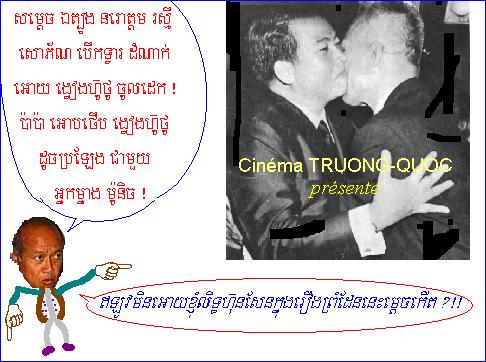 Zones Blanches ou Tel Père, Tel
Fils.
Zones Blanches ou Tel Père, Tel
Fils. |
De petits partis nationalistes se lancent
dans l'inspection des tracés frontaliers (2005-Mai-24)
Cambodge-Soir : L'appel lancé
il y a une dizaine de jours par le Roi-Père Norodom
Sihanouk aux citoyens de vérifier la réalité
des tracés frontaliers et de constater d'éventuels grignotages
du territoire national n'est pas resté sans réponse. Deux
petits partis, composés essentiellement d'étudiants, dont
le nationalisme anti-viêtnamien constitue un pilier idéologique,
ont envoyé leurs militants dans les provinces frontalières
pour mener l'enquête. "Après l'appel de l'ancien roi Norodom
Sihanouk, nous avons établi un programme de visite dans les provinces
frontalières avec le Viêt-nam. Nous nous occuperons ensuite
de la frontière khméro-thaïlandaise. Le problème
avec Preah Vihear a été créé par le gouvernement
pour faire diversion. Là-bas, les problèmes sont moins graves",
explique Im Sinath, l'un des responsables du Front
des citoyens khmers.
Une vingtaine de membres ou sympathisants de ce groupe viennent de rentrer
d'une première mission d’inspection dans le district de Romeas Hèk
de la province de Svay Rieng, et le parti s'apprête à envoyer
son rapport à Norodom Sihanouk à Pékin. Se basant
sur des entretiens réalisés avec des anciens par ses militants,
Im Sinath assure qu'en certains endroits, la frontière aurait reculé
"de 5 à 10 kilomètres". Lors de ce déplacement,
il affirme que son groupe a été en contact avec des militaires
viêtnamiens qui leur auraient interdit de photographier le Viêt-nam
depuis le Cambodge. Selon lui, la "tactique" employée par le pays
voisin pour grignoter des terres khmères serait souvent la même.
"Ils creusent un canal, installent un poste de
contrôle. Puis dès que notre attention se relâche, ils
remblaient le canal. Et c'est ainsi qu'ils avancent sur notre territoire",
explique le militant. Ce dernier assure par ailleurs que les effectifs
militaires viêtnamiens auraient été renforcés
dans le secteur de Daung.
Le Mouvement des étudiants pour la démocratie,
une formation concurrente du Front sur le terrain du nationalisme, a également
dépêché la semaine dernière quelques militants
pour le même genre de mission. Dans un rapport envoyé au Roi-Père,
ce mouvement assure avoir observé un point où la frontière
aurait reculé de 17 kilomètres. Pour sa part, le Parti Sam
Rainsy qui conteste la gestion gouvernementale des questions frontalières
mais qui est désormais représenté au sein du Conseil
national supérieur des affaires frontalières par son
président, estime inutile, pour le moment, ces missions d'observation.
"Il faut laisser pour le moment travailler le Conseil", juge Son
Chhay, député du parti d'opposition.
Nhim Sophal
Sihanouk piqué au vif (2005-Mai-21)
King-Father rejects a $10 million donation
from Brunei
Samngatki : On 18 May 2005, King-Father Norodom Sihanouk turned
down a $10 million donation from the Brunei-based “Sultan Haji Fund For
development”. The King-Father has consistently reproached the current Cambodian
government for indulging in corruption, mismanaging our national resources
and shamefully turning Cambodia into a beggar nation. See King-Father’s
rejection letter :
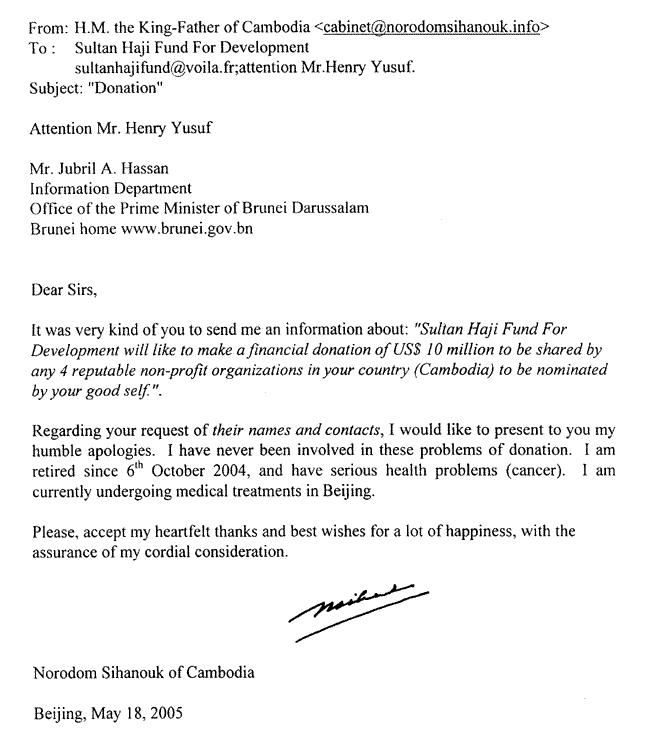
N.P. : Cher
Samngatki, je ne sais rien de ce M. Henry Yusuf (en France ?) et du Sultan
Haji Fund For development. Mais si l'ex-roi Sihanouk a
pris la peine de leur répondre, c'est que c'était sérieux.
Le gouvernement cambodgien est corrompu et rend misérable le petit
peuple ? Raison de plus pour accepter ce don (s'il est sans conditions
politiques). Tout ce qu'on a demandé au prince c'est de donner quatre
noms de ONG (qu'il connaîtrait mieux que son fils le roi régnant).
Je crois plutôt que Sihanouk, froissé par ses opposants et
humilié d'être depuis longtemps à la remorque de la
Chine et de la Corée du Nord, a voulu, pour une fois, soigner son
amour-propre. Mais alors, ce serait ... un mendiant qui refuse l'aumône.
Une absurdité de plus dans la vie politique du prince !
Quelques Photos Du Cambodge (2005-Mai-17)
From rectra...@yahoo.com : ARK Research
"New Khmer Architecture 1953-1970"
Helen Grant Ross (1/12/04) : Darryl Collins, Historian and myself,
have been researching the enlightened territorial development and high
attainment in architecture that were part and parcel of the Sangkum
Reastr Niyum, for the past 5 years. Our manuscript is in the hands
of a publisher. We have inventoried over 1300 works built between 1953
and 1970 and studied over one hundred in detail. Also we have established
biographies for over 50 architects and engineers. I would like all your
readers to know that the most remarkable construction of this period, the
National Sports Complex, designed by Vann
Molyvann, Architect dplg, is under threat of extinction if the
public do not manifest their concern about the present work being done
by Yuanta. In 2000 Yuanta and the Ministry
of Education, Youth and Sport, signed a contract in which a 70-year lease
literally gave Yuanta "carte blanche" to build whatever they liked in the
National Sports Complex. When I say "in'' I don't
mean "around". They have built in the drainage system that surrounds
the NSC. This tacky corrugated iron roofed structure brings in valuable
rent from shopkeepers. At the same time it has destroyed the water treatment
system that was an integral part of the NSC. Worse still, along Sihanouk
Bd, 3-storey shops and apartments have been built without any foundations,
supported only by the walls of the water tanks.
Not only this is life-threatening to the ignorant
people who might buy or rent these buildings, but the water has been drained
and the underground water tanks transformed into paying car parks. The
water tanks covered about 1/6th of the total land surface of the NSC and
guaranteed the excellent drainage of the sports facilities especially during
the wet monsoon. The state of the sports facilities is rapidly deteriorating.
Although the well designed sports field survived over 30 years of neglect
and was still being used until Yuanta
took over, it is now unusable. As for the magnificent building that houses
a sports hall seating 8.000 spectators, nobody can get access to it at
present. The Centre for Social Development organized a Public Forum
about this in December 2002 and a petition with 3.300 signatures was sent
to Hun Sen. A clause in the contract
allows for an audit of the quality of work done by Yuanta to be effected
and a public enquiry should be set up to assess the consequences of this
disastrous work to one of Cambodia's most important National
Heritage.
http://www.nytimes.com/2005/05/15/magazine/15CAMBODIA.html?pagewanted...
http://www.phnompenhpost.com/full/papers/is1211/is1211/build.htm
http://www.reyum.org/exhibitions/exhibition11/page/04.htm , http://www.katours.org/
Rottanakvongsa : The building looks good. The National Sports Complex
was ugly after the Khmer Rouge. [soc.culture.cambodia]
N.P. : Moi, j'aime le style colonial pré-indépendance,
comme ce vieux quartier de la ville de Kampong Cham. Les photos suivantes
ont été prises sous le règne de l'association royalo-communiste
Hun Sèn-Ranariddh, en été 2004.
Certains
préfèrent vivre et travailler dans la forêt (qui reste),
comme cet ouvrier dans une plantation d'hévéas à Choup.
En tout
cas, à défaut de la sécurité (des crimes meurtriers
se multiplient au Cambodge) et de la vraie paix, les citoyens peuvent toujours
en rêver en allant voir cette sculpture (plutôt soudure) dénommée
Oiseau de la Paix, sur le monticule qui a donné son nom à
la capitale, le Phnom Dohn Penh.
GOD
vs BUDDHA
|
camboDIATRIBE
(
PRÉCÉDENT )
|
COURRI@L
2005
|
AUTRES
SITES KHMERS
|
KUN
PIMOJ 's HOMEPAGE
|
PHN@M-P@NH-P@TINS
|
FRAN-GLO-GIBWÉ
|
CANADA
3 FOUNDERS
|
MES
EMAILS 2003
|
THE
6 COMMANDMENTS
|
MEET
WITH GOD
|
PEN Nearovi, Montréal, Québec, Canada
(nearovi@sympatico.ca)


